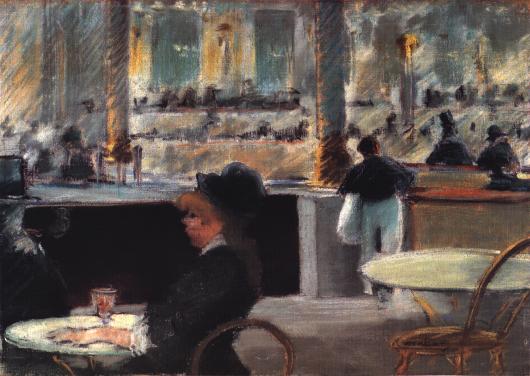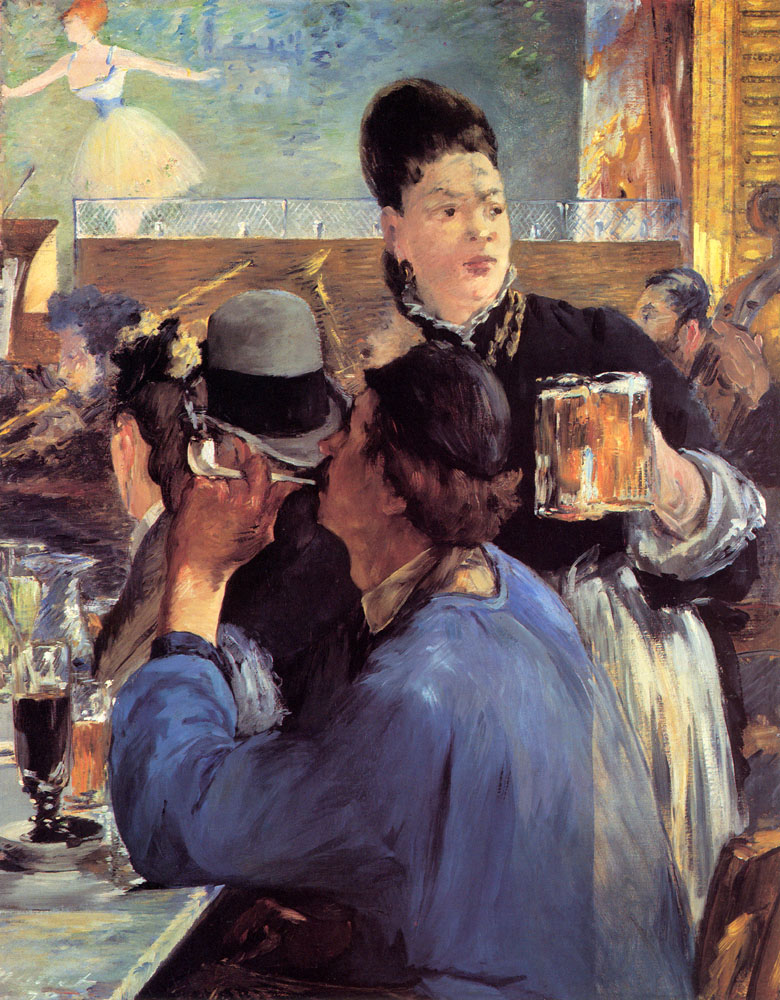 A Cafe, Place du Theatre Francais
A Cafe, Place du Theatre Francais
1877-78
oil on canvas 32x46cm
Glasgow Museums
Manet’s Café-Concert (1878)
Edouard Manet's varied scenes of Parisian cafés are almost always described as sociological observations, as though copying reality was his objective. Art historians like Linda Nochlin, with an interest in sociology, are particularly prone to that interpretation. Like artists, they paint themselves. We all tend to. It cannot be so, of course, because, if you have learnt anything from this website, you will have learnt that great artists never copy what they see....and Manet's scenes in cafés are no different.At first sight the most curious feature of this painting is the lifeless figure of the smoking woman at left. Yet when one knows her source - the earlier figure on which she is based - her oddness begins to make sense.
 The most famous of these spots is perhaps the“Café Guerbois”. With the slightly older Edouard Manet as a respected leader, many of those who later were to become world famous, around 1870, met there regularly for lively discussions and some drinking – Edgar Degas, Claude Monet, Pierre-Auguste Renoir, Alfred Sisley, Paul Cézanne, Camille Pissarro, not forgetting Frédéric Bazille (see below). They were also joined by Emile Zola, who did a lot to promote these painters, to be known as the “Batignolles Group”. One of the painters was Henri Fantin-Latour who made a famous painting in Manet’s workshop, where we can recognize Manet painting, surrounded by Renoir, Zola, Bazille, Monet… The café is not there anymore; today replaced by a men’s clothing shop. The drawing from the place is by Manet.
The most famous of these spots is perhaps the“Café Guerbois”. With the slightly older Edouard Manet as a respected leader, many of those who later were to become world famous, around 1870, met there regularly for lively discussions and some drinking – Edgar Degas, Claude Monet, Pierre-Auguste Renoir, Alfred Sisley, Paul Cézanne, Camille Pissarro, not forgetting Frédéric Bazille (see below). They were also joined by Emile Zola, who did a lot to promote these painters, to be known as the “Batignolles Group”. One of the painters was Henri Fantin-Latour who made a famous painting in Manet’s workshop, where we can recognize Manet painting, surrounded by Renoir, Zola, Bazille, Monet… The café is not there anymore; today replaced by a men’s clothing shop. The drawing from the place is by Manet.
The immediate neighbour was the cabaret and restaurant “Père Lathuille”, founded in 1765 and to which is linked a specific event during a battle between the Russian and French troops in 1814, which took place just around the corner. The owner offered free meals and drinks to the French soldiers: “Eat and drink, my friends. Leave nothing to the enemy”! Manet made a famous painting, “Chez le Père Lathuille” (1879). The place is still there but completely transformed. In 1906 it became « Kursaal » where among others Maurice Chevalier performed. Later it was transformed to a cinema theatre and so it’s still today, since 1996 a quite specific one, “Le Cinéma des Cinéastes” supported by some of the leading French film makers and concentrating on quality films. Some old equipment is exhibited and on the walls behind I would like to believe that some of the original decoration has been saved. (There is also a small bar, which has inherited the “Père Lathuille” name.)
On the other side of what used to be the “Café Guerbois” is a small shop. Founded in 1830 under the name of Hennequin. This is where Manet and the future impressionist painters bought their paint and brushes. It seems that it has since more or less stayed with the same family although the painting equipment lost its importance. The shop has been sold and was closed December 31, 2010. It will now probably be transformed to a shop for cheap shoes or something similar. At least, the nice mosaic decoration should be saved.

Not far away (Rue La Condamine) used to be a workshop (the building has been replaced) where Frédéric Bazille made a painting of his painter colleagues, visiting him. It seems that Renoir, Monet and Sisley at moments have occupied the same workshop. Bazille was the only one of the group who was fairly wealthy and he often shared his workshops with some of his poor colleagues. He was extremely talented, but was killed in 1870, at the age of 29, during the Franco-Prussian war. On the painting we can see him (his face painted by Manet) surrounded by Manet and Monet. Zola on the stairs is discussing with Renoir. Zola lived on the other side of the street in a backyard. The building is still there and I managed to slip through the gate, but when I tried to take a photo I was more or less kindly asked by a lady to leave the premises. (I took a photo through the small opening under the gate.)

You have a feeling that the group got along well together. There are a number of paintings where they have portrayed each other. Here are some examples. (It may be noted that when Bazille moved from one workshop to another, the chair followed.)
Another person who met with the “Batignolles group” at “Café Guerbois” was Nadar, who as from 1850 took photos of most of those days’ celebrities – Liszt, Wagner, Berlioz, Rossini, Offenbach, George Sand, Sarah Bernhardt, de Maupassant… and some painters. What was to become the start of impressionism was an exhibition which took place in Nadar’s workshop in 1874. The building is still there, but of course transformed (Boulevard des Capucines). Cézanne, Degas, Guillaumin, Monet, Morisot, Pisarro, Renoir, Sisley… exposed and the name of impressionism was created thanks to some (negative) critics referring to Monet’s“Impression, soleil levant” ("Impression, sunrise", see also top picture), painted in 1872. This painting is today to be seen at the Marmottan Museum , which has the world’s most complete collection of Monet paintings (and other artists).


Dr. Gachet was another visitor to « Café Guerbois ». An art sponsor and collector, he’s of course especially related to van Gogh. It may be worth mentioning that van Gogh (together with Toulouse-Lautrec) managed to exhibit at the “Grand Bouillon-Restaurant du Chalet” a bit further down Avenue de Clichy, around 1888, during the short time he lived in Paris. He made also a painting of the place. Of course he didn’t sell anything. But now we have left the impressionists for the post-impressionists. The restaurant has of course disappeared, replaced by a modern building and a supermarket.

l
 A Cafe, Place du Theatre Francais
A Cafe, Place du Theatre Francais


 The most famous of these spots is perhaps the“Café Guerbois”. With the slightly older Edouard Manet as a respected leader, many of those who later were to become world famous, around 1870, met there regularly for lively discussions and some drinking – Edgar Degas, Claude Monet, Pierre-Auguste Renoir, Alfred Sisley, Paul Cézanne, Camille Pissarro, not forgetting Frédéric Bazille (see below). They were also joined by Emile Zola, who did a lot to promote these painters, to be known as the “Batignolles Group”. One of the painters was Henri Fantin-Latour who made a famous painting in Manet’s workshop, where we can recognize Manet painting, surrounded by Renoir, Zola, Bazille, Monet… The café is not there anymore; today replaced by a men’s clothing shop. The drawing from the place is by Manet.
The most famous of these spots is perhaps the“Café Guerbois”. With the slightly older Edouard Manet as a respected leader, many of those who later were to become world famous, around 1870, met there regularly for lively discussions and some drinking – Edgar Degas, Claude Monet, Pierre-Auguste Renoir, Alfred Sisley, Paul Cézanne, Camille Pissarro, not forgetting Frédéric Bazille (see below). They were also joined by Emile Zola, who did a lot to promote these painters, to be known as the “Batignolles Group”. One of the painters was Henri Fantin-Latour who made a famous painting in Manet’s workshop, where we can recognize Manet painting, surrounded by Renoir, Zola, Bazille, Monet… The café is not there anymore; today replaced by a men’s clothing shop. The drawing from the place is by Manet.







No comments:
Post a Comment